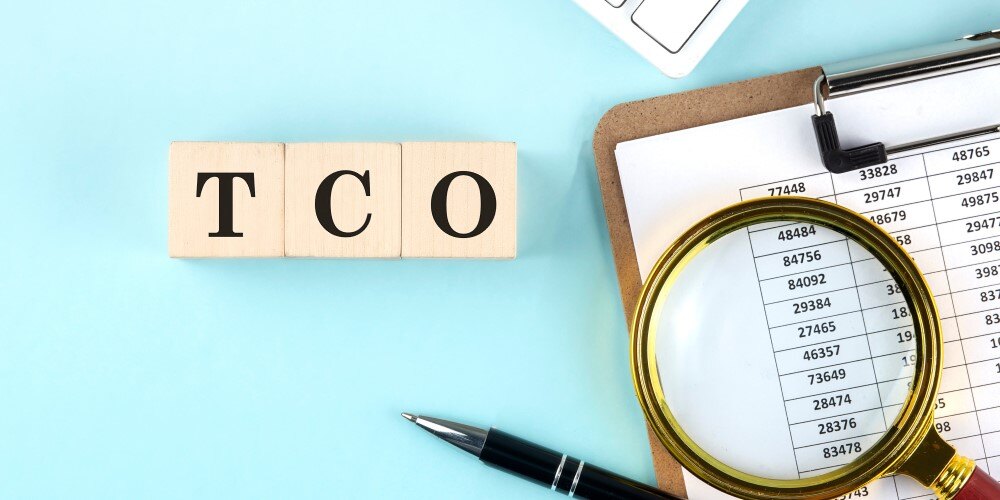How do you know when replacing rather than repairing an asset makes more financial sense? Total cost of ownership (TCO) is a crucial figure for asset management and budget control that many FMs simply don’t have access to. Here’s why and how facilities managers need to take control of their assets at TCO.
What is your "total cost of ownership"?
TCO is the record of all the money you have spent on an asset over its lifetime, including its acquisition, operation, maintenance, and eventual disposal. The total of ownership can be hard to uncover, as the 'hidden costs' in downtime and inefficient servicing remain stubbornly unseen.
How is TCO broken down?
- Acquisition and installation account for between 20 and 25% of most asset’s TCO
- Operation and maintenance typically account for between 75% and 80% of the average TCO before the asset breaks down or becomes so inefficient it must be retired.
As this diagram points out, the older an asset becomes, the more maintenance it requires and the more it costs to own and operate.

It also shows that if your business has no means of managing your assets, depending only on reactive maintenance to keep them operational, the cost of ownership will dramatically increase.
However, if your business is capable of managing your assets (tracking and optimising their efficiency through preventive and predictive maintenance), you can:
- Minimise expensive reactive repair work
- Increase asset lifespan
- Decrease total cost of ownership.
Tracking your evolving TCO will indicate when it’s time to upgrade
By tracking the TCO of your assets over time - it will also become clear when the cost of servicing and repair will begin to outweigh the overall value the asset generates for you.
Most experts agree that when an annual or one-off repair cost reaches more than 65% of the replacement cost, you should assess whether investment in new equipment is required.
But this decision-making process to replace or repair is always a delicate balancing act.
TCO and the art of asset life-cycle management
As the global asset management standard ISO 55000 highlights, the goal of smart asset management is to juggle cost, risk, and performance over an asset’s entire lifespan to get the most value from it. If you over-maintain an asset, you’re wasting money; if you under-maintain it, you’re setting yourself up for breakdowns, downtime, and expensive emergency repairs.
Being able to track and project the total cost of ownership, therefore, is vital to be able to weigh the pros and cons of replacement.
But ISO 55000 also emphasises the bigger picture—you shouldn’t just assess an asset in isolation but in the context of your entire organisation’s operational and financial strategy. That means understanding how asset performance impacts efficiency, compliance, and long-term budget planning of your business as whole.
To do this, you need data that most facilities managers simply don’t have.

Why DIY digital asset management doesn’t work
Without a digital asset management system, keeping track of your TCO can feel like guesswork. If you’ve been relying on shared servers and Excel sheets, chances are you don’t have a full picture of how much you’ve actually spent on each asset over its lifecycle - or be able to correctly project the future cost of the asset or its replacement..
With a mix of internal engineers and contractors handling maintenance over the years, some costs will inevitably slip through the cracks.
Routine servicing, component replacements, and emergency call-outs may not have been consistently recorded, especially when things were rushed or paperwork was overlooked.
Over time, key details get lost—lines on spreadsheets go missing, incomplete records pile up, and crucial information like warranty coverage gets forgotten. This could mean paying for repairs that should’ve been free, missing warning signs of asset failure and struggling to justify replacement decisions when it matters most.
To get things sorted out, you need to take control of your assets - digitally.
We were running FM in our business using spreadsheets and email. A lot of data and knowledge was stored in the heads of our teams, and being lost to the business. We needed to change it into usable data. A CAFM is doing that for us.
Shakeel Jivraj, Head of Operations for Queensway Coffee Houses
How to take control of your assets and TCO
The first step toward managing TCO effectively is getting your assets listed in a digital register (such as a CAFM).
The right CAFM system should give you the tools to start recording the details of existing assets in a single place, giving you end-to-end visibility of their condition and, ultimately, their TCO.
What data do you need to track your TCO?
Your chosen CAFM system should be capable of dynamically tracking and calculating ownership costs using the following data:
- Purchase costs – The initial investment, including any interest if financed.
- Maintenance costs – Repairs, routine servicing, and professional fees.
- Operational costs – Energy, water, fuel, taxes, IT services, etc.
- Financing costs – Financing details, including interest and fees.
- Depreciation – A formula for calculating loss in value over time.
- End-of-life costs – Disposal, demolition, or recycling fees.
By combining these, you should be able to see each asset’s current value in real-time and figure out whether it’s generating more costs than they are worth.
But it’s not enough just to track your TCO through a CAFM’s digital asset register.
Choosing the right CAFM should help you actively manage your TCO. It should help you optimise engineer and contractor performance to keep assets in the required condition, while preventing costly operational and compliance failures.
What’s more, the digital platform you chose should be able to give you all the asset analytics you need to make key life-cycle decisions. And it should give you this information in the form of configurable dashboards; with all the charts and graphs that can help you win the internal arguments for CAPEX investment.
4 ways a CAFM system can help control your TCO
1. Better contractor management
A CAFM system enables more effective contractor oversight. They can ensure you are getting maximum co-operation from your supplier relationships; with external engineers dedicated to reduce the cost of asset management and improve their performance.
Key benefits include:
- Avoid over-billing & inefficiencies with automated job tracking and performance analytics, you can ensure that contracted work is completed on time and within budget.
- Compare contractor performance to select suppliers who are performing more efficiently
- Ensure you are levering existing warranties with suppliers gain maximum value for money.
- Improve first-time fix rates by tracking contractor response times and repair quality.
- Real-time asset condition reporting, helping facilities teams make informed decisions on repairs vs. replacement.
Contractor uptake is key to TCO tracking
But, don’t forget - adoption of a new CAFM systems by engineers and third parties can be hard to achieve. Persuading contractors to migrate to your way of doing things - and use your software to log their time and activity can be an uphill battle
Make sure your CAFM partners bring a seamless experience for engineers on the ground to maximise uptake. Provide an easy-to-use mobile portal with QR code access, allowing quick job logging, instant invoicing, and performance tracking. Incentivizing contractor use through quicker payments and transparent performance reviews can further boost engagement.
Without your contracrtors logging every detail of their asset management activity on your CAFM you will never get a handle on your TCO
The big goal for us was getting contractors on board, so we could monitor their activities and control our spending with them. Contractors are now using the system to record their time and manage their site visits. We have got excellent feedback from them, and we continue to listen and speak to them every day.
2. Managing preventive maintenance
A preventive maintenance strategy is crucial for reducing unplanned downtime and extending asset life, directly impacting TCO.
With a CAFM system, you can:
- Automate maintenance schedules based on asset condition and usage patterns.
- Reduce emergency repairs by ensuring assets are maintained before failures occur.
- Use predictive analytics to identify assets likely to fail, allowing for early intervention.
Preventive maintenance ensures long-term cost savings by reducing repair expenses, minimising disruptions, and improving asset reliability.
3. Improving compliance & reducing risk
Total cost of ownership can be inflated by failing compliance and efficiency levels within your assets.
A CAFM system can help FMs avoid costly compliance failures by:
- Ensuring all maintenance is logged, providing a clear H&S audit trail.
- Tracking statutory inspections and regulatory compliance deadlines.
- Centralising documentation for HSE, RIDDOR, and ISO standards - reducing the risk of fines for out of date paperwork.
A digital asset management system will also help you automatically track downtime, service frequency, and repair costs that contribute to your TCO.
High-level analytics will then make it simple to spot:
- Recurring problem assets that frequently break down.
- Outliers in energy consumption or maintenance spend.
- Patterns in contractor performance (e.g., repeated service calls or delayed repairs).
This visibility into historical performance helps you project future costs and strategically manage the total cost of ownership over time.
4. Enhancing asset lifecycle management
A centralised asset management tool in a CAFM should provide a clear picture of asset conditions, usage, and replacement needs.
It should bring the lifecycle data together in user-friendly ways, so you can clearly see the decisions that need to be taken around CapEx:
- Optimised capital planning, ensuring replacements happen only when necessary.
- Lifecycle cost analysis, helping FMs compare repair costs vs. replacement costs.
- Standardisation of procurement decisions, ensuring cost-effective, long-lasting assets are selected.
The right asset management software can help you analyse groups of assets to see if bulk purchasing will present opportunities to negotiate with suppliers over costs e.g. 10 fridges at a better price than buying them individually when required.
Josh Greibach, CEO and Co-Founder, Expansive Solutions
TCO data is vital for strategic asset management
Many FMs struggle with outdated or fragmented asset data, making lifecycle planning difficult. A CAFM system eliminates reliance on siloed data sources and ensures asset information remains visible and accessible.
Managing TCO across an enterprise with many locations is certainly a challenge, but it doesn’t have to be a shot in the dark. With the right data, tools, and processes in place, businesses and facilities teams can make the best data-driven decisions to calculate and manage their TCO and use their budget strategically.
For more insight into strategic asset management and how you can solve your repair or replace dilemmas, download our expert guide to digital transformation.
.png?width=680&height=700&name=Ai%20page%20module%20(2).png)


